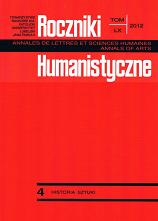Ludomira Sleńdzińskiego podróże do Włoch 1923-1925 - geneza i dojrzewanie klasycyzmu
Ludomir Sleńdziński's trips to Italy 1923-1925 The genesis and ripening of classicism
Author(s): Katarzyna Nowakowska-SitoSubject(s): Cultural history
Published by: Towarzystwo Naukowe KUL & Katolicki Uniwersytet Lubelski Jana Pawła II
Keywords: classicism; return to order; Italian art of the 1920s; classicism in Polish art of the 20th century; Polish-Italian artistic relations in 20th century
Summary/Abstract: Two trips to Italy that Ludomir Sleńdziński, the main representative of classicism in Polish art in the period between the two World Wars, went on in 1922/24 and 1924/25 are the subject of the article. They have not been yet considered in the context of the genesis and character of his work, albeit impulses coming from Italy were thought to be an important catalyst for the birth of the so-called return to order. Sleńdziński was Dymitr Kardowski’s pupil at the Academy of Fine Arts in St Petersburg, and it was from his workshop that he acquired a worship of the old masters and a perfect command of his trade, first of all a perfect ability to draw. Apart from the St Petersburg school trends of classicism came to Polish art from Paris, where they first could be noticed in the circles connected with the periodical Museion (1911-1913), and with the artists belonging to the Polish colony, such as Henryk Kuna, Edward Wittig and Eugeniusz Zak. In the article I reconstruct Sleńdziński’s stays in Italy, and I remind about the exhibition of Polish modern art that he staged in 1925 as part of Terza Biennale Romana. His personal contact with old and modern Italian art became an important moment in his artistic formation, stimulating his departure from academic towards modern classicism, in which the artist starts playing a game with the present day and with tradition, consciously using stylistic elements that belong to different epochs. In conclusion it must be said that Ludomir’s trips inclined him to introduce many new solutions (sometimes surprisingly close to works by well-known Italian artists with a similar orientation) and decided the final shape of his mature work.
Journal: Roczniki Humanistyczne
- Issue Year: 60/2012
- Issue No: 04
- Page Range: 37-56
- Page Count: 20
- Language: Polish

